Istanbul's plan to save its cultural soul
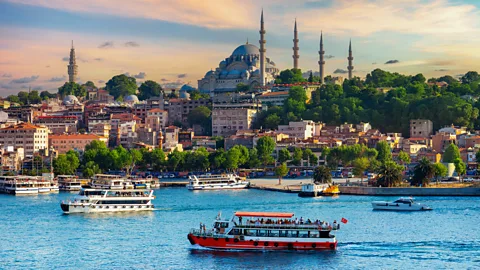 Getty Images
Getty ImagesAn extensive culture and heritage restoration campaign is revealing previously overlooked layers of the world's most visited city.
For decades, the dome-topped turret of the Bulgur Palas in Istanbul's central Fatih district could only be glimpsed peeking out over the top of the high walls that surround this abandoned century-old mansion. Now the palace offers sweeping, panoramic views of the Marmara Sea, the city's minaret-studded historical peninsula and its skyscraper-studded new business district in the distance.
Restored and reopened in February 2024 as a cultural centre, complete with a 150-seat library, exhibition space, garden cafe and observation terrace, this former residence and Ottoman Bank archive is one of dozens of previously inaccessible sites across Istanbul – ranging from Byzantine-era fortifications to late-Ottoman-period factories – that have been opening to the public over the past five years. The result is a wealth of newly restored attractions that reveal little-known historical and cultural layers in the world's most-visited city.
"Istanbul cannot fit into a single photograph; wherever you go in the city, you can find these little gems," says Mahir Polat, who has spearheaded this city-wide restoration drive since 2019 as deputy secretary-general of the Istanbul Metropolitan Municipality (İBB).
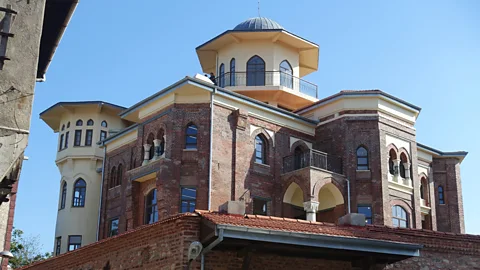 Jennifer Hattam
Jennifer HattamAccording to Polat, the restoration projects aim to create new public spaces in the dense metropolis and breathe new life into neglected historical sites that were at risk of earthquakes and further urban development. But they may also point towards a more sustainable tourism strategy for a city straining under the weight of 20.2 million international visitors in 2023 – a 26% leap compared to 2022. Lines often stretch down the block to get into top sights such as Topkapı Palace, home to the Ottoman sultans; the Byzantine-church-turned-mosque Hagia Sophia; or the ancient underground Basilica Cistern.
"Tourists always tend to go to the same places, which can create problems anywhere in the world," says tour guide Sinan Sökmen, the founder of Istanbul Tour Studio. "These additional landmarks have the potential to spread tourism around."
As an example, Sökmen points to the Gülhane Park Cistern, a 1,500-year-old reservoir that was restored by the municipality and reopened to the public in early 2023. Just a 10-minute walk from its larger, more popular cousin, Gülhane is only one piece of a city-wide cistern system once comprising more than 200 underground and open-air reservoirs that provided water to the city's residents. It sits inside a leafy park that was part of the private grounds of Topkapı Palace and is also home to the Column of the Goths, perhaps the oldest extant Roman monument in the city, and the Alay Köşkü, a gem of a 16th-Century pavilion where the Ottoman sultan would view his parading troops.
This kind of multi-layered history is everywhere in Istanbul, which was founded in the 7th Century BCE and catapulted to power to become the seat of the Roman, Byzantine and Ottoman empires. Today, it remains the only place in history to have been the capital of consecutive Christian and Islamic empires, and the only city in the world spanning two continents: Europe and Asia.
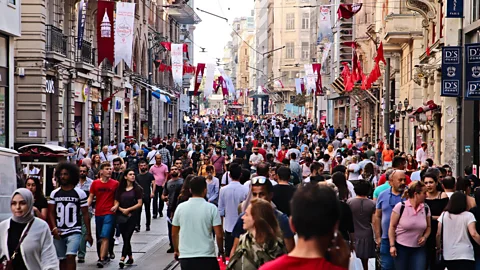 Alamy
AlamyIn the century since the creation of the modern Turkish Republic in 1923, Istanbul's population has soared from fewer than 1 million people to a sprawling megalopolis of roughly 16 million people (the largest city in Europe), spurring a building boom that has left ancient monuments marooned in seas of concrete. The rapid pace of change has also created a newer set of at-risk cultural landmarks: 19th and early 20th Century residential and industrial sites that have been abandoned and neglected despite the important chapters they represent in Istanbul's evolution.
When author Ayşe Övür was a university student in Istanbul in the 1990s, she and her friends would frequent cafes on İstiklal Caddesi, a broad thoroughfare in the Beyoğlu district that had been a fashionable address during the latter days of the Ottoman Empire. On these excursions, her eye was particularly drawn to the ornate Art Nouveau decorations on one building: a 1901 apartment where Dutch fashion designer Jean Botter, the official tailor to the Ottoman palace, had his home and atelier.
"Not only the sultan's family, but also other rich and famous people of the era came to Botter for their clothes," says Övür, who used the building as the setting for her 2019 novel, Botter Apartmanı. She says Botter was the first person in Istanbul to establish a fashion house, introduce the white wedding dress to Turkish society and host fashion shows, making him an important symbol of broader Europeanising trends at the time.
Later rented out to publishing houses and other commercial tenants, the once-majestic building had sat empty for decades by the time the Istanbul municipality started the process of restoring it in 2021. It reopened in April 2023 as Casa Botter, a public art and design centre with rotating exhibits featuring Turkish modern and contemporary artists.
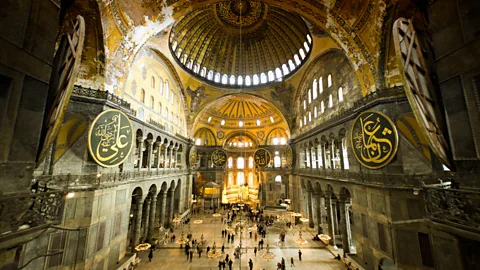 Getty Images
Getty ImagesOn the other side of the Golden Horn, a 19th-Century weaving factory that initially produced fezzes and military uniforms is now hosting an exhibition of 20th-Century optical and kinetic art from the Tate Collection. The restored building, now known as Artİstanbul Feshane, was one of the city's first to be constructed from steel; its original cast-iron columns, brought to Turkey from Belgium, are still in place.
Preserving and revitalising Istanbul's industrial heritage sites, which form a crucial part of the city's transition from the Ottoman to Republic era, has been one of the focal points of the municipality's restoration efforts. Rapid industrialisation began in Istanbul in the mid-1800s as part of the late Ottoman Empire's modernisation drive. The Golden Horn, the waterway spanned by the popular Galata Bridge, was once home to shipyards, slaughterhouses, tobacco, flour and brick factories and the Ottoman Empire's first urban-scale electrical power plant. But as in other global cities, manufacturing has largely been relocated in recent decades to industrial parks on the urban fringes, leaving these early factories to decay.
"Previous administrations made a big mistake by tearing many of these buildings down in the past decades; we lost that history forever," says Polat. Because many of the sites that remain are located outside areas traditionally visited by tourists, he hopes restoring these buildings and transforming them into things like galleries, event spaces and cafes can help create new centres of attraction for both locals and travellers alike.
The municipality's approach has not been without its critics. "Industrial heritage is only valued in terms of protecting the structure," says Gülsün Tanyeli, an architecture professor at Istanbul Technical University. She argues that these revitalisation efforts don't do enough to convey to visitors how these former sites fit into the city's cultural and historical fabric.
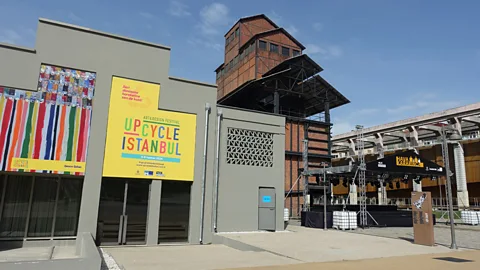 Jennifer Hattam
Jennifer HattamTanyeli consulted on the municipality's restoration of Hasanpaşa Gazhane, a former gasworks in a residential neighbourhood of the Kadıköy district. In the 19th and early 20th Centuries, this facility burned coal to fuel Istanbul's street and indoor lighting; today, it's a sprawling cultural complex, Müze Gazhane, that features a climate museum, a cartoon museum, cafes, a library and exhibition spaces. But Tanyeli says she wishes visitors had been given more information about the production processes that took place there – and about the two-decade-long struggle by local activists to protect the gasworks from destruction – so they could better understand the site's greater importance.
The ongoing restoration of Istanbul's fragile 5th-Century city walls has also been criticised by urban activists who say the work has failed to sufficiently preserve garden plots along their base where food has been grown for centuries.
More like this:
• The most Istanbul thing to do in Istanbul
Overall, though, the restoration projects seem to have been eagerly embraced by Istanbul residents, which Sökmen says creates "living places" that give visitors the opportunity to engage with contemporary daily life in the city.
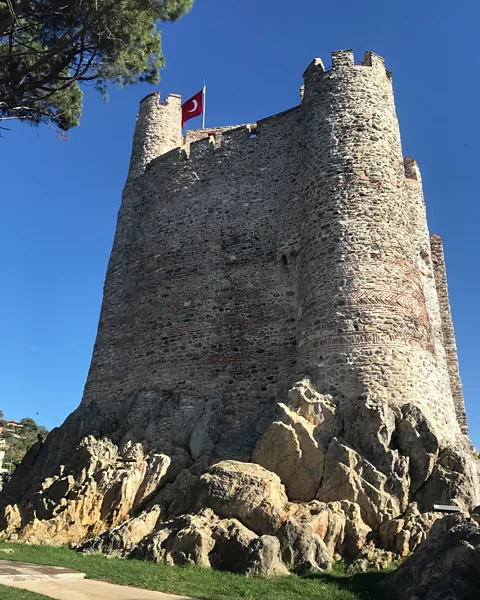 Jennifer Hattam
Jennifer HattamAt Anadolu Hisarı, the oldest Ottoman fortress in Istanbul, ramparts once patrolled by soldiers now bustle with families and couples smiling for selfies above the sparkling waters of the Bosporus. Built on the Beykoz waterfront in 1395 to help establish Ottoman military dominance over the strategically important strait, the fortress was last restored in 1953 and had been closed off for more than a decade until its reopening in May 2023. On summer nights, its illuminated towers make a dramatic backdrop for free open-air concerts organised by the municipality.
"The history of Istanbul is its biggest treasure," says Polat. "By protecting this heritage and making it available for everyone to experience in their daily lives, we believe Istanbul will be loved even more."
--
If you liked this story, sign up for The Essential List newsletter – a handpicked selection of features, videos and can't-miss news, delivered to your inbox twice a week.
